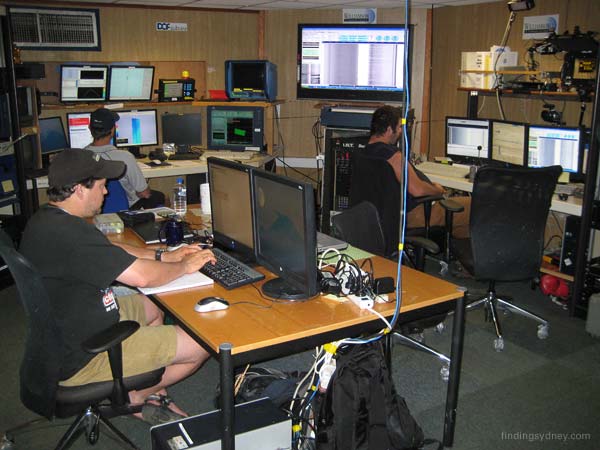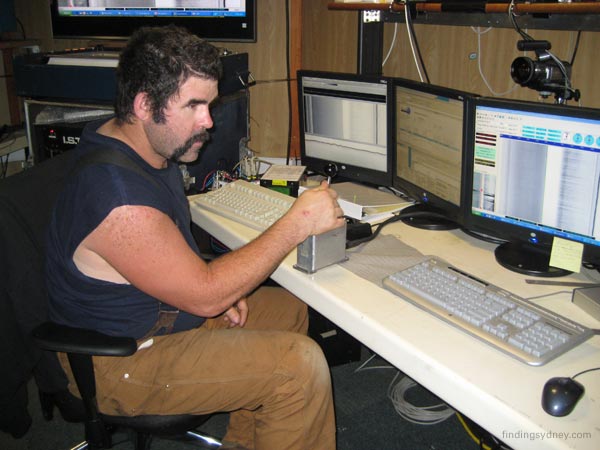David Mearns - Search Director, The Finding Sydney Foundation
The most anxious time for any search is the first sonar trackline through the search area. This is when you learn whether the area you are searching consists of either rough geological terrain or a flat smooth seabed. You also learn for the first time whether the weather and sea conditions will allow you to tow the sonar in the direction and speed your desire without difficulty. Complications due to rough geology and/or uncooperative weather and sea conditions can make all the difference to whether a search ends successfully, or in failure.
As our sonar was tracking through the initial section of our first trackline (actually Line # 07 as per our line-naming convention) I started to get very concerned that luck wasn't going to be on our side. The seabed geology wasn't that awful, but it certainly wasn't going to be easy to detect a shipwreck amongst all the geological formations that cluttered our screens. The Geosounder's watch officers were also finding it difficult maintaining the perfectly straight trackline we require at the slow speeds of 2.5 knots. The combination of the two difficulties, amongst a number of other technical issues, made the first few hours searching very uneasy.
As the sea is ever changing, however, so was our fortunes and a couple of hours later the seabed started to get very flat and featureless (ideal terrain for shipwreck hunting) and the Geosounder began crabbing down the line at an angle that maintained good steerage as well as speed. It always takes some time to iron out the kinks and for a search to take on a pattern and rythm of efficiency and this is what first tracklines are for. We can only hope that our good fortune continues although experience tells me that there are many twists and turns to come.
The following series of pictures show the main survey room on the Geosounder where the Williamson & Associates search team and DOF Subsea navigators work.

The above photograph shows the central control room where all the search sonar, survey and positioning equipment is operated from and data is logged. It comprises three main work stations which are shown in following photographs.

Above photograph shows the navigator's station for operation of the Differential Global Positioning System and Mult-Beam Echo Sounder Systems.

Above photograph shows the sonar operator's station where he "flies" the towfish altering its height above the seabed.

Above photograph shows the off-line station for post-processing of the side-scan sonar data.
John Perryman - Senior Historian, Royal Australian Navy (Observer)
Today’s dawn followed a successful night of trials on the Williamson sonar equipment which had been successfully deployed during the previous night and recovered in the early hours of the morning.
A visit to the bridge and a quick study of the chart revealed that we were now steering north-west towards our search box at around about 8 knots. We expect to arrive in the area where the epic battle between Sydney and Kormoran is believed to have taken place at around about midnight.
As we enter these waters, one can’t help but try and imagine what it must have been like for the crews of both vessels on that fateful day in November 1941. I suspect that others on board have had similar thoughts as we get down to the business end of the search which will commence as soon as we reach our midnight position.
Throughout the mobilization and during the voyage there have been many discussions amongst the team concerning the Sydney and Kormoran as our international friends have come to learn more about this tragic episode of Australia’s Naval history.
For more information concerning HMAS Sydney (II) visit: www.navy.gov.au/spc and visit the ship history pages.
IMPORTANT NOTICE: The Material (including photographs) available in the "Press Room" section of this Website may be used/reproduced unaltered by your organisation (unless stated otherwise within the content description) subject to the terms and conditions set out in the Legal Section AND any Material (including photographs) which you use/reproduce must credit the source as "The Finding Sydney Foundation" and, as an option, you may also link the source statement with the website address http://www.findingsydney.com/.